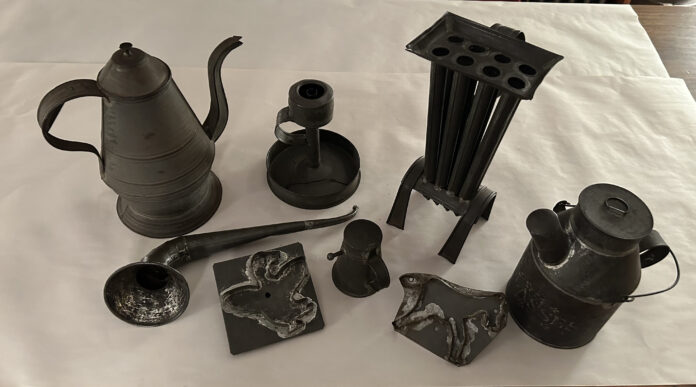
Tinker derives from the 15th-century verb “tink.” The word means to mend, solder rivet or repair and is said to come from the sound that a worker of tin makes when striking metal with his tools. A more modern definition describes the tinker as a person who is skilled in various minor kinds of mechanical work, a jack-of-all-trades if you will.
Regardless of definition, the tinker — or tinsmith as the trade later came to be known — was a vital craftsman in the development of a pioneer community. In stature, the tinsmith ranked closely behind the blacksmith and the potter as a person who could craft wares that were much needed by residents of a rural hamlet.
At the time the Ohio Country was being settled, tinsmithing was a comparatively new trade in the young nation. During the American Revolution neither tinplate nor finished tinware goods were available from Great Britain, which held a virtual monopoly on tinplate. It wasn’t until after the American Revolution that tinplate was again exported from England and the availability of tinware began to be advertised in American newspapers.
Tinware on the frontier
The earliest tinware that was available in the Ohio Country came from manufacturers in New England and Pennsylvania where tinsmiths dispatched peddler wagons loaded with tinware of all kinds to backwoods settlements. There it was sold to housewives yearning for new vessels and utensils to replace the worn-out ones they had brought with them on their covered wagons.
Many of those peddlers, in addition to being colorful characters in general, were themselves tinsmiths who could repair and rebuild the “poor man’s silver” pots and pans when new wares were not affordable. Often these traveling smiths would barter for their goods, accepting for payment anything from sheep pelts and maple syrup to in-season fruits and vegetables, flax and goose, hen and turkey feathers. While the majority of these peddlers were said to be legitimate businessmen, vast numbers of tales abound about those who were scalawags, more intent on bothering the farmer’s daughter or wife than peddling tinware.
Tinsmiths

Tinsmiths were far less numerous than were blacksmiths and potters. Because of this, there were fewer notices seeking apprentices published in newspapers. It should also be noted that the 19th century marked the discontinuance of what had traditionally been long periods of apprenticeship to learn trades. Furthermore, because tinsmithing as a trade did not gain real momentum until after 1812, it never had the vigorous formal training of some other crafts. For this reason, the tinsmith was somewhat looked down on by other craftsmen, despite the fact his skills were very much in demand.
The development of an American machine, which was advertised as being suitable for use by the unskilled, eliminated the need for lengthy training periods. According to both oral and written accounts, many of the 19th-century tinsmiths seem to have picked up the trade haphazardly, simply learning a little here and a little there throughout their lives. Often entrance to the trade was through education gained as youngsters when a relative who was an active smith helped them to bend and solder scrap tin into cookie cutters.

The tools of the tinsmith were quite simple and usually slung over the shoulder in an oval tin canister called a “pig.” Those tools typically consisted of bars of solder, a small anvil for doing rough shaping, soldering irons of various sizes, tin snips for cutting, folders for making straight crimped-over edges, various grades of wire to reinforce seams and a small brazier. That stove would be fired with charcoal for heating the soldering irons, also known as “coppers” because the heads were blocks of copper which absorbed and held heat better than other available metals.

Tinsmiths often employed patterns for various vessels such as coffee pots, teapots, cream pitchers and sugar bowls, which were passed down from one generation to the next. Such patterns were for making lids, spouts, bottoms, handles, the main body of the vessel, and reinforcing elements.
Tinware
While most people tend to think of the tinsmiths as primarily crafting pots and pans, the variety of items they made was hugely varied and encompassed genres from kitchenwares to farming tools and a vast number of other categories. One item they made that immediately comes to mind, previously mentioned, was cookie cutters. Over the years tinsmiths undoubtedly crafted millions of tin cookie cutters, probably the majority of them being in Pennsylvania German communities where residents literally made bushel baskets full of cookies during the holiday seasons. Those cutters, still found in astounding numbers, included such subjects as farm animals, circus animals, musical instruments, hearts, tulips and other flowers, items of clothing, bells, religious symbols, birds of every species, guns and rifles, Indians, horses and riders, Santa Clauses, axes, boats, mermaids, fish of every kind and many, many more.
In the area of kitchenwares, they crafted pie crimpers, spatulas, ladles, cake and bread pans, strainers, scoops, measures, tumblers, graters, colanders, ash covers, cheese molds, egg poachers and much more.
Household and farm items included lanterns and parade torches, boot and mitten dryers, candle molds in a multitude of shapes and sizes, many different types of lighting devices, squirrel cages, tumblers and mugs, bird cages, ear trumpets, musical horns and spice and candle boxes. They also made sconces, clothes boilers, apple roasters, tin kitchens for roasting meat, baby nursing bottles, lunch buckets and water buckets, spice, snuff and storage boxes, quilt templates and Christmas decorations of all sorts. Many of these various items were extensively decorated with punchwork or so-called wrigglework designs that often included floral, bird and patriotic motifs or various combinations thereof.
Without the services of a tinsmith, frontier living would have had far fewer conveniences and been much less interesting a place in general.













I think I used that copper soldering iron in my 7th grade metal shop class in 1969 to make a spice rack.